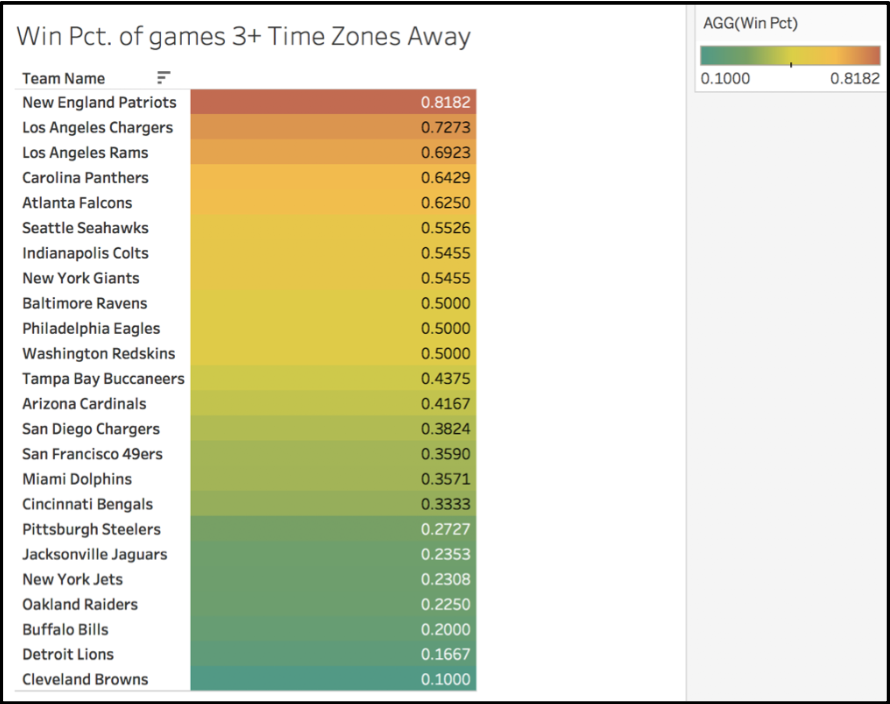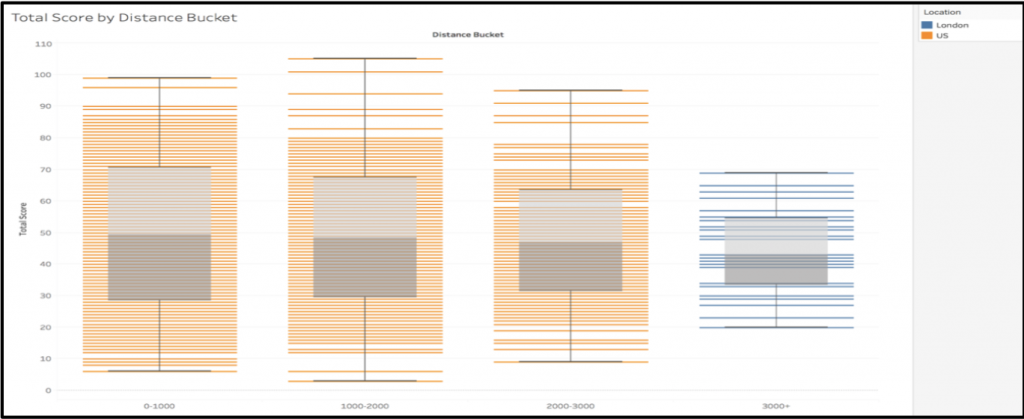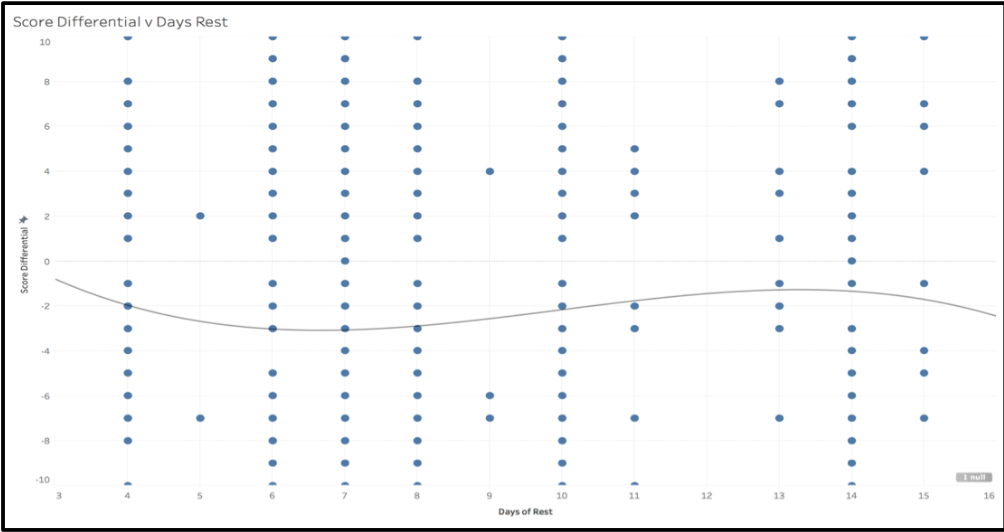By Gareth Jobling – Syracuse University ’20
Abstract
This research aims to analyze the effects of travel on teams in the National Football League, as well as the feasibility of adding a team overseas in London, England. To measure the effects of travel I used distance traveled, time zones crossed, whether the travel was westbound or eastbound, and days of rest as variables for each NFL game played between 2007 and 2019. This data is combined with team performance data as well as running totals and running averages for each of the performance statistics for each game. I created a model to capture the effects of travel on the outcome of the game. This model was then applied to determine that if a team was added in London whether they would be at an advantage or disadvantage in games and how those results could be balanced across the league.

Introduction
The NFL’s presence in London has been constantly growing since 2007, the start of international series games played overseas. The London games have been so successful that there is talk of adding a full-time team to London. There are surely positives to that as well as negatives, but there are also a lot of question marks. Many of these question marks revolve around the logistics of adding a team to London. Lots of heavy equipment needs to be transported from game to game, and this type of overseas transportation is not cheap.
One thing that has come into question, but often gets overlooked because of all the logistical problems, is how having a team in London will be able to compete with teams in the United States due to all the wear and tear on their bodies from travel? Often times we hear of players getting injured or players not at peak performance due to the impact of travel on a player’s body. As a player gets affected by travel, this in turn would affect the team. We have access to data that can help answer these questions of how travel can affect the team’s chances of winning, or the outcome of the game. This study aims to answer how travel affects the outcome of the game.
Method
The first set of models in this study focuses on the score differentials for away teams. Using each game’s score difference allows us to see if there is an effect of distance travelled on the outcome of the game, whether improving the team’s chances of winning or not. The first model in this set is a linear regression with Score Differential as the dependent variable and distance in miles, the absolute value of the number of time zones crossed, whether the travel was westbound, days of rest, and running averages of the performance statistics for the travelling team as well as their opponents. We would expect that distance travelled1, number of time zones crossed2, and westbound to all have a negative impact on the score differential as suggested by previous research on other sports. We would also expect that running average statistics such as average passing interceptions and average opponent score would have a negative impact on score differential. Running average statistics such as average own score and average passing touchdowns should have a positive impact on score differential as well as days of rest before the game. When looking at the opposing team’s average statistics we would expect to see them have the opposite effect on score differential compared to the same statistics for the travelling team.

The other model in this set replaces the running average statistics with dummy variables for the travelling team as well as dummy variables for the opponents. In this model we would expect distance in miles, the number of time zones crossed, and travelling westbound to have a negative effect on the score differential and days of rest to have a positive impact on the score differential. The dummy variables for each team should follow a trend based on how successful each team was throughout the years used in this dataset. So, a team like the New England Patriots should have a higher positive impact on score differential whereas a team like the Cleveland Browns would have a negative impact on the score differential due to their contrasting levels of success between 2007 and 2019.
Results
The first model in this study is the linear regression model that includes running averages for the travelling team and opposing team. In this model we can see that running average variables average own score, average pass completions, average rushing attempts, opponent average opponent score, and opponent average punt yards are all significant and positively impact the score differential for the away team. Average opponent score, average passing attempts, average pass completion percentage, average punt yards, and average 3rd down attempts are all running average variables that have a significant and negative impact on the score differential. Now looking at the travel variables we see some surprising results. Distance in miles, number of time zones crossed, and westbound all are not significant in explaining away team score differentials. Only playing games on a weekly basis and not as often as MLB and NBA teams could play a role in this. Days of rest however, is significant at the 5% level. As days of rest increases, this has a positive increase on the away team’s score differentials. If days of rest before the game increases by 1 this increases the score differential by approximately .257 points so for every 4 days of rest the away teams score differential should improve by 1 point.

The second model uses dummy variables for the travelling team and opponent team rather than running averages of various team statistics. Distance travelled, the number of time zones crossed, and westbound travel are not significant in the model. Days of rest is significant but only at the 10% level. In terms of the team dummy variables in this model, teams with a history of success between 2007 and 2019 are strongly significant and positive. Teams like the Falcons, Ravens, Packers, LA Chargers have a significantly positive impact on score differentials at the 5% level and teams like the LA Rams, Patriots, Saints, and Steelers have a significantly positive impact on score differentials at the 1% level. The Oakland Raiders and St. Louis Rams are the only teams to have a significantly negative impact on the score differentials. In terms of who the travelling team played we can see that playing these same successful teams have a negative impact on the score differentials. The Ravens, Packers, Patriots, Saints, Eagles, Steelers, San Diego Chargers, and Seahawks all have a significantly negative impact on the away score differentials. Playing the Raiders and St. Louis Rams are the only two opposing teams that have a significantly positive impact on score differentials. It seems that playing a strong team or weak team has a larger impact on score differential than any of the travelling variables.
Conclusions
From these analyses performed in this study we are able to answer the question whether or not the effects of travel play a role in determining the outcome of the game in the NFL, and thus amplify these effects of games played in London. The short answer to this question is no, many of the travel variables do not have a significant effect in predicting the outcome of the game.
In this analysis we looked at 4 main travel variables: distance travelled in miles, number of time zones crossed, whether the travel was westbound or eastbound, and days of rest between games. As we saw, the only variable that is significant in determining the outcome of the game is days of rest. Distance travelled, number of time zones crossed, and westbound travel are all insignificant in every model in this thesis. We can say that the only travel factor that plays a significant role in determining the outcome of the game is days of rest. This means that adding a team to London won’t seem to lead to an advantage or disadvantage for that team. It may be a good idea, however, to still consider incorporating homestands and back to back games in the U.S. for the team in London, and maybe even having its own practice facility in the United States. Some of the strategies talked about to alleviate the effects of travel could not be represented in this analysis but may be something to look into in future studies.
References
1. Barnwell, Bill. “NFL’s Frequent-Flier Phenomenon.” Grantland, July 4, 2012. http://grantland.com/features/packing-miles-hurt- team-overpaying-kicker/.
2. J.K. “Road Warriors.” The Economist. The Economist Newspaper, August 21, 2012. https://www.economist.com/game- theory/2012/08/21/road-warriors.
Acknowledgements
I would like to thank Dr. Paul and the professors in the Sport Analytics department for all of their help and support throughout the process of writing my thesis.
